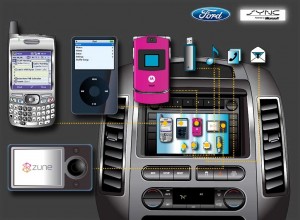
Ford's latest Sync update expanded the capabilities of the system but failed to completely resolve ongoing consumer complaints.
Ford has good reason to take claim for kick-starting today’s automotive infotainment revolution. Its Sync system was the first to really put the technology in the eye of the American consumer, ushering in an era where motorists can access everything from music apps like Pandora to social media such as Facebook while driving.
But while Sync initially led millions of potential buyers to consider Ford products, an assortment of problems with Sync and the related MyFordTouch and MyLincolnTouch interfaces has resulted in countless others steering clear of the maker – Ford watching its quality scores slumping as a result of those issues.
So there’s probably little surprise that the automaker is about ready to un-friend Microsoft, the Seattle-based software giant that supplies the underlying technology behind Sync – and which has gotten much of the blame for glitzing screens, slow responses and balky touch interfaces. Instead, the Detroit maker is expected to shift to the QNX operating system developed by BlackBerry Ltd.
That could be a major setback for Microsoft just as it gets ready to inaugurate a new CEO. The Sync system – and the similar Kia UVO technology – were billed as highlights of the software firm’s technical prowess and its desire to make major inroads into the automotive world.
(Ford produces 10 millionth Sync-equipped vehicle. Click Herefor the story.)
On the other hand, it would be a major coup for Ontario-based BlackBerry, which has had little more than trouble to show for its recent efforts, its once-ubiquitous smartphone system now lagging in the market despite the kudos received by its latest upgrade.
“This would be a huge infusion of trust and confidence to have BlackBerry and QNX expanding into a Ford,” Thilo Koslowski, auto analyst for researcher Gartner Inc., told the Bloomberg News Service.
BlackBerry hasn’t had much go right for it in recent years, losing 95% of its once sky-high stock valuation over the past five years, watching a recent $4.7 billion buyout deal collapse, and seeing a number of top executives forced to leave.
For Ford, it remains to be seen whether the switch to QNX as the back end of its Sync system will solve its problems with Sync, but there’s little doubt it needs to do something. Ford has been plagued by a variety of malfunctions in recent years, taking a serious hit in third-party metrics, including reviews by influential Consumer Reports magazine, as well as a series of consumer surveys by J.D. Power and Associates.
The maker plunged in Power’s latest Initial Quality Survey, and while the consulting firm noted problems with some of its powertrain technologies, the bulk of the complaints involved Ford’s infotainment systems, explained lead auto analyst Dave Sargent. Owners were particularly frustrated by:
- User interfaces that made it difficult to do even the simplest tasks, such as changing temperature or tuning the radio;
- Voice control systems that couldn’t understand commands or executed them incorrectly;
- Systems that would not pair with a motorist’s smartphone.
Such issues are not limited to Ford, analysts caution, but the maker has been disproportionately hurt by the glitches, and “few can be fixed,” Sargent noted, without major upgrades from the factory.
(Automakers join the smart watch procession. Click Here for more.)
Some sources suggest Ford would like to upgrade some, perhaps all, of the current fleet of Sync-equipped vehicles to run on QNX. There are currently 10 million Ford vehicles using the Microsoft operating system.
None of the three companies would comment on the reports.
It’s unclear if there is any connection between the apparent decision to pull the plug on Microsoft and the recently-ended search for a new CEO for the Seattle-based company. Ford CEO Alan Mulally had been considered a leading candidate for the job but announced he would stay in Detroit early last month.
(For more on Mulally’s decision to stay with Ford, Click Here.)
